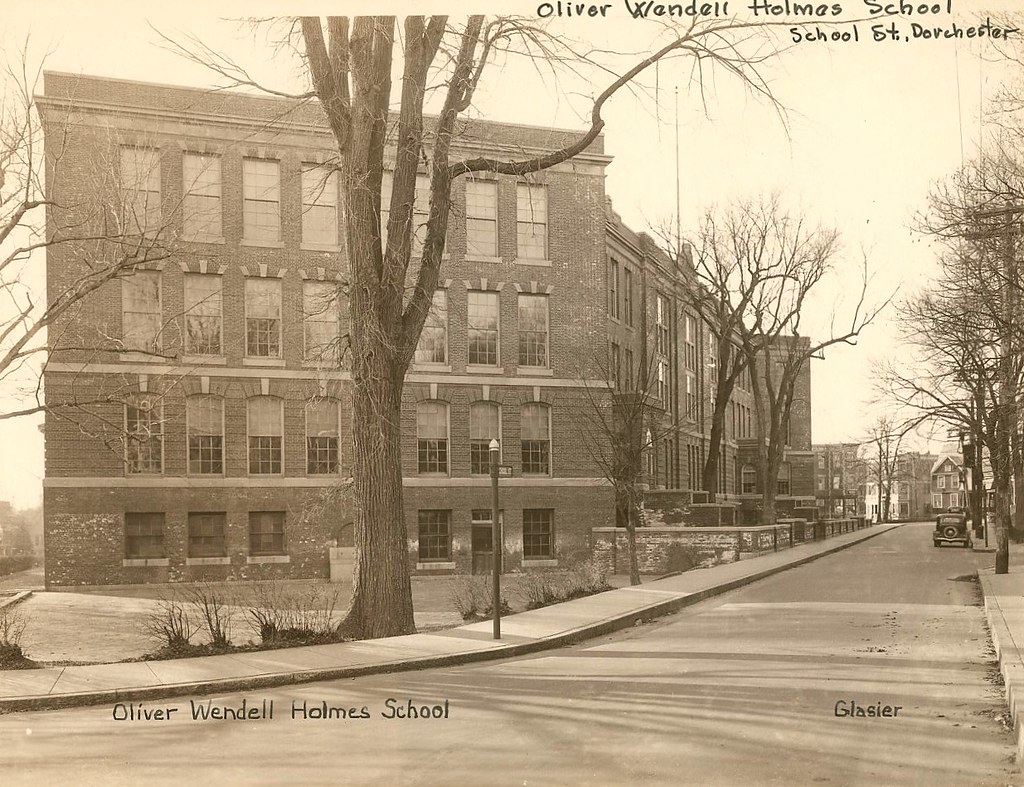Middle School

Oliver Wendell Holmes School, Dorchester, Boston, MA. Photo courtesy of Boston City Archives.
The desegregation of Boston public schools began during the 1974-1975 school year with the implementation of Phase I. Phase I was a limited desegregation plan that sought only to correct student racial imbalance. This plan was short-term and designed to meet the limited requirements of the Racial Imbalance Act of 1965. By the early 1970s, five of the 19 middle and junior high schools in Boston were 85 percent black while seven were more than 87 percent white.[i]
Middle school students shared a variety of opinions on desegregation. Some were against being sent to different schools while others believed that this was a step in the right direction for the city. Some students even had suggestions for Mayor Kevin White as to what he could do to fix the schools.
Why would middle school students be against the desegregation plan? Were they actually against desegregation? Did they even know what desegregation meant? Or were they simply scared by what they saw in the media and in neighborhoods?
The first letter shown is from a student at the Oliver Wendell Holmes School in Dorchester, MA. This particular student supported Mayor Kevin White and encouraged him to continue his mission to desegregate the schools. Not all students, however, were as positive as this.
Part of the Phase I desegregation plan included compulsory busing of students between areas of Boston where black and white students lived close by. Charlestown, East Boston and the North End were excluded during this time.
The desegregation plan aroused fierce protest among Bostonians, particularly concerning the busing of students. A number of students attended neighborhood schools and many parents wanted to keep what they believed was a "neighborhood school system." Contrary to what was widely believed, Boston's school system was not one in which all students walked to their neighborhood schools. By the early 1970s, around one-third of Boston's students used public transportation for school.[ii] Despite this fact, many students were against being bused to schools in other neighborhoods.
The letter on the right is from a student at the Oliver Wendell Holmes School in Dorchester. The student wrote to Mayor Kevin White asking that students not be bused to South Boston. It is not clear whether this student would be bused the following year to South Boston, but they did not think it was right for other students living in Dorchester to be bused. Written in October 1974, South Boston was already in the news for weeks due to the protests and violence that erupted in the neighborhood over desegregation. It is possible that the student was against busing from the violence portrayed in the media.
One of the schools affected by Phase I was the Oliver Wendell Holmes Middle School in Dorchester, MA. Dorchester is a neighborhood in Boston and one of the most diverse. In the spring of 1975, a sixth grade teacher at the Holmes school sent a collection of essays from his students to Mayor Kevin White. The essays document the students' experiences in an integrated classroom during Phase I. Their views demonstrate a variety of opinions based on their personal experiences during the school year.
This particular student was scared to attend an integrated school. He believed that white people would gun down the buses and that in school, black and white students would sit at opposite ends of the classroom. This student dealt with his fears by acting out in class. He believed that if he misbehaved, he would be expelled from the Holmes school and sent elsewhere. He also mentions that he could not wait to go home after school because that is where he felt safe. However, after several months at the Holmes school he found out that he had a lot in common with another student that frequently acted out. They soon became best friends and would even spend time together after school.
Almost all of the essays from students at the Holmes School admitted to being anxious and even scared to attend an integrated classroom. These students handled their initial anxieties and fears differently. Some remained quiet while others acted out. Many of the students remarked that they had no idea what integration was at first, or what they were to expect from an integrated class. During the course of the school year, desegregation diminished in importance and was replaced with field trips and other classroom activities. To some, their descriptions may seem trivial, but these essays are nothing but honest evaluations of those most closely affected by desegregations: the kids.
Students at the Oliver Wendell Holmes Middle School experienced Phase I differently from other schools in Boston. It experienced little to no violence during the school year and the students adapted to an integrated school immediately. What made the Holmes school different from that of South Boston High School? Was it the location? The teachers? Or was it because they were younger than those in high school? They were just as anxious and frightened to be bused and attend an integrated school as the older students were, but they did not experience the same amount of violence. The middle school students adapted quickly to desegregation and immediately saw the similarities between themselves and students of a different color.
Listed below are related items to this section of the exhibit. There is a letter to Mayor Kevin White from a middle school student as well as numerous essays from other students at the Oliver Wendell Holmes School.
______________________________________________________________________________
i. School Desegregation in Boston: A Staff Report Prepared for the Hearing of the U.S. Commission on Civil Rights in Boston, Massachusetts, June 1975. Washington: Commission, 1975, 21.
ii. Ibid.
Resources:




















